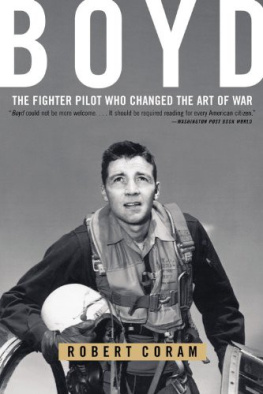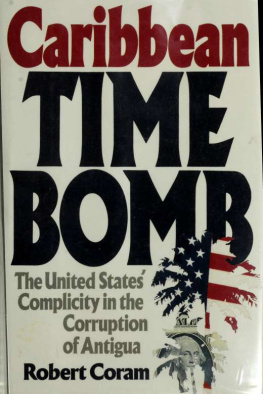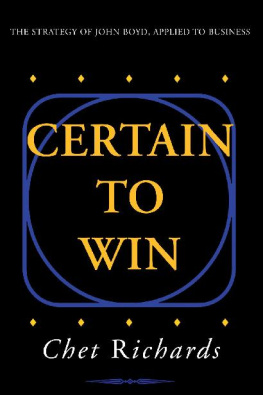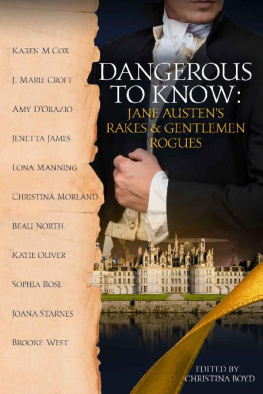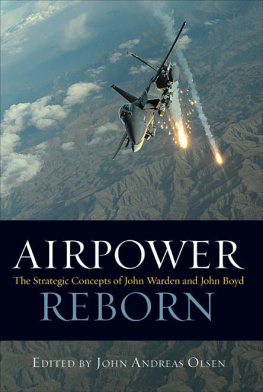RARELY has a writer approached a subject where so many people were so anxious to help. This was not because of my winning ways and bubbling personality; it was because John Boyd inspired such passionate feelings among those who knew him and who wanted to be sure his story was told in the proper fashion.
Researching this book brought me into frequent and lengthy contact with the men who were close to Boyd: the Acolytes. The distance I always keep between myself and the people I write about disappeared when I met these men. For my more than two years of researching and writing this book, Franklin Chuck Spinney was the go to person for everything I needed. Him I owe the most. Chuck Spinney, Tom Christie, Pierre Sprey, Ray Leopold, Jim Burton, and Mike Wyly are as fiery and idealistic today as they were back in the 1960s and 1970s and 1980s. For the endless hours they spent with me going over those white-hot yearsand for their friendshipI shall always be grateful.
Mary Boyd, Kathy Boyd, Jeff Boyd, and John Scott Boyd could not have been more forthcoming during many talks about their family. Often it was painful for everyone involved. Mary Ellen Holton, as Boyds executrix, was particularly helpful in obtaining personal family papers.
It is a measure of the respect Boyd evoked that Vice President Dick Cheney took time to talk about his old friend. The generosity of his comments added much to the book.
Of the dozens of others who helped, a few must be singled out. Jack Shanahan, a brilliant Air Force officer, spent months walking me through Air Force history, Air Force culture, the subtleties of Officer Efficiency Reports (ERs), the intricacies of air combat, and a hundred other details of Air Force life.
Grant Hammond was always willing to share the insights that came from spending hundreds of hours with Boyd in the mid-1990s.
Vernon Spradling remains the institutional memory of the Fighter Weapons School as it was in the 1950s and 1960s. He proves that memory does not have to decline with age.
Ron Catton has the wisdom that comes from having a wild youth followed by a distinguished Air Force career and a highly successful business career. His guidance was invaluable.
Chet Richards is a consultant and lecturer on Boyds ideas as applied to business. He has the keen logic of a mathematician and he saved me from many mistakes.
Dr. Wayne Thompson at the Office of Air Force History provided documents I might never have known about.
At Georgia Tech, Bob Harty, Marie McVay, Debbie Williamson, and Kathy Tomajko brought depth and dimension to the chapter about Boyds two years at that respected institution. And my friend Grady Himself Trasher spent hours telling me of Tech as it was during his student days in the early 1960s.
Jim Stevenson knows all there is to know about airplanes. He shared his knowledge.
For about thirty years, a group of men has met every Wednesday night in the Officers Club at Fort Myer, across the river from Washington. In few other places in America can you find a room filled with men who have made more of a contribution to national defense than these men have. They are legends all. And they are why I always timed my trips to Washington so I could be there on Wednesday.
A few additional notes.
I happen to have the best literary agent in New York. Mel Berger of the William Morris Agency gets the job done. Quickly.
This book covers a long and tumultuous time in American military history. To insure accuracy, many people mentioned in the book have read part or all of the manuscript. Any errors, however, are mine alone.
I edited the manuscript on St. Catherines Island. No writer ever had a better place to work, and I am forever grateful to my good friend Royce Hayes, the superintendent of that remote island off the Georgia coast.
Finally, my deepest appreciation as always is to my wife, Jeannine Addams. My life has been altogether different because of her.
El Cid Rides On
JOHN Richard Boydas is often the case with men of great accomplishmentgave his work far greater priority than he did his family. The part of his legacy that concerns his family is embarrassing and shameful.
Today Mary and Kathy and Jeff continue to live in the two-bedroom apartment in Delray Beach. Except for workmen, no one who is not a member of the family ever enters. One reason is that Mary says the apartment is jammed and cluttered and she is too embarrassed for others to see it. Another reason is Jeffs collection of snakes and tarantulas and insects. He says that today he has only a seven-foot bull snake and a few others, but as he says this, he ducks his head and looks around as if fearful someone might overhear him. Mary worries that word of Jeffs collection might get out and she wonders how the apartment management might react. Her friends have repeatedly asked her to kick Jeff out, but she cant bring herself to do that. She receives about one thousand six hundred dollars monthly from social security and a pension, and she drifts along, wondering what will happen to Kathy and Jeff after she is gone.
Her concern is justified. Kathys depression has deepened and her inability to cope with the world has grown. She says she was diagnosed with schizo-affective disorder and she talks of the voices she hears, critical and condemning voices telling her what a bad person she is. Occasionally she sees a psychiatrist who asks about her antidepressant drugs and sends her on her way. Three days a week she works at a facility for those with mental disorders. She is afraid to ride the bus so either Mary or Jeff drives her. She is well into her forties, but her anger toward her father is unabated.
For a while Jeff worked part-time at a nature preserve, but he was let go. He says he lost the job because he is principled and honest and these attributes make people uncomfortable. He is moving into his forties and, like Kathy, suffers from depression. He will not take medication. He says married women find him very attractive and that they frequently make advances but that he always turns them down. His portfolio is filled with drawings of spiders and snakes and insects, truly outstanding sketches. He could sell many of them, but refuses to do so. He spends hours every day lying across his mothers bed, talking on the telephone. He says Mary has helped him financially but not emotionally.
John Scott, who now uses only his first name, lives in California, where he works in the computer industry. His hobby is building motorcycles. Alexander, his young son, is named for Alexander the Great. John wanted to name him Alexander Genghis but instead named him Alexander John. The John is for his father. His animosity toward his father is such that the other members of the family wondered if he would come to the funeral. He did, but the anger lingers. Now he wants his son to grow up to be an Air Force fighter pilot. Sometimes he quotes his father and sometimes he admits that he misses him terribly. When things are not going well in business, he thinks of his dads sense of integrity and duty and finds the strength to press on.
Mary Ellen writes computer manuals and lives outside Washington. Although she is the youngest child, she is easily the strongest person in the family. She handles all the details of her fathers estate and watches closely over his papers and books at Quantico. She has Boyds old phone book, which contains an unlisted number for the line between the Pentagon and Dick Cheneys home. She is very much like her father: direct, painfully honest, and at times loud and boisterous. Mary Ellen is divorced. She sometimes wonders if the depression that runs in the Boyd family might one day surface in her daughter, Rebah.
Mary Ellen and John Scott, the two children who for so long fought with their father, tried to join the military. Both were refused, Mary Ellen because of allergies and John Scott because of a juvenile run-in with the law.

